
The spoonhead sculpin is a species of freshwater ray-finned fish belonging to the family Cottidae, the typical sculpins. This species is widespread in northeastern North America.

The Pacific staghorn sculpin is a species of marine ray-finned fish belonging to the family Cottidae, the typical sculpins. This species is found in the eastern Pacific Ocean. It is the only species in the monospecific genus Lepidocottus.
The sturgeon chub is a species of ray-finned minnow fish in the family Cyprinidae. It is found only in the United States. It is a species of concern in the Charles M. Russell National Wildlife Refuge in Montana.

Semotilus atromaculatus, known as the creek chub or the common creek chub, is a small minnow, a freshwater fish found in the eastern US and Canada. Differing in size and color depending on origin of development, the creek chub can usually be defined by a dark brown body with a black lateral line spanning horizontally across the body. It lives primarily within streams and rivers. Creek chubs attain lengths of 2–6 inches (5.1–15.2 cm) with larger specimens of up to 12 inches (30 cm) long.

The rainwater killifish is a small silvery fish with yellow flashes and diamond shaped scales that is widespread from Cape Cod, Massachusetts, through to Tampico, Mexico. It is commonly found in large numbers in fresh to brackish estuarine environments. It feeds on tiny crustaceans, mosquito larvae, small worms, and mollusks. It can reach up to 62 mm.
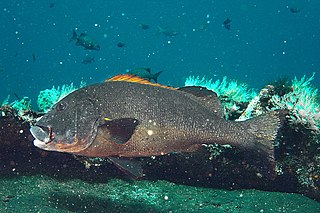
Plectorhinchus albovittatus, the two-striped sweetlips or giant sweetlips, is a species of marine ray-finned fish, a sweetlips belonging to the subfamily Plectorhinchinae, part of the grunt family Haemulidae. It is native to the Indian Ocean and the western Pacific Ocean.

The coral hawkfish, the pixy hawkfish or sharp-headed hawkfish, is a species of marine ray-finned fish, a hawkfish belonging to the family Cirrhitidae. It is native to tropical reefs of the Indian Ocean and the Pacific Ocean. It occasionally is found in the aquarium trade.
The silver chub is a species of freshwater fish of the family Cyprinidae found in North America.
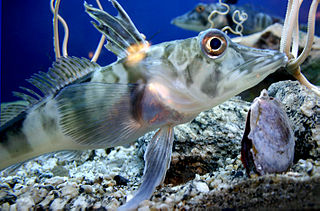
Chionodraco hamatus is a species of marine ray-finned fish belonging to the family Channichthyidae, the crocodile icefishes. It is found in the Southern Ocean.
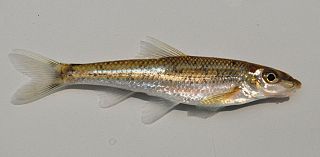
The gravel chub, also known as the spotted chub, is a freshwater minnow from the family Cyprinidae. This species of fish has a spotted distribution inhabiting various small rivers and streams in North America. The gravel chub requires a highly specific clean habitat making it vulnerable to various types of pollutants and in need of conservation efforts.

Prionodraco is a monotypic genus of marine ray-finned fish belonging to the family Bathydraconidae, the Antarctic dragonfishes, its only species is Prionodraco evansii. These fishes are native to the Southern Ocean.

The longfin icedevil, also known as the threadfin pinhead, is a species of marine ray-finned fish belonging to the family Nototheniidae, the notothens or cod icefishes. It is native to the Southern Ocean where it can be found at depths down to 850 metres (2,790 ft). This species grows to a length of 42 centimetres (17 in) TL. This species is the only known member of its genus and is of no interest to commercial fisheries.

Sebastes ensifer, the swordspine rockfish, is a species of marine ray-finned fish belonging to the subfamily Sebastinae, the rockfishes, part of the family Scorpaenidae. It is found in the northeastern Pacific Ocean.

Sebastes elongatus, the greenstriped rockfish, striped rockfish, strawberry rockfish, poinsettas, reina or serena, is a species of marine ray-finned fish belonging to the subfamily Sebastinae, the rockfishes, part of the family Scorpaenidae. It is found in the northeastern Pacific Ocean.
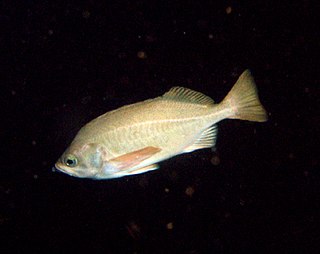
Sebastes ovalis, the speckled rockfish, is a species of marine ray-finned fish belonging to the subfamily Sebastinae, the rockfishes, part of the family Scorpaenidae. It is found in deep rocky areas of the Eastern Pacific.

Sebastes semicinctus, the halfbanded rockfish, is a species of marine ray-finned fish belonging to the subfamily Sebastinae, the rockfishes, part of the family Scorpaenidae. It is found in the Eastern Pacific.
Aphyocypris lini, the garnet minnow or Venus minnow, is a species of cyprinid endemic to China. It was first collected from Hong Kong by A.W. Herre in 1936. The introduction of mosquitofish and habitat destruction caused the extirpation of this species from Hong Kong and the species was considered to be extinct in the wild. However, a similar species Aphyocypris pulchrilineata was discovered in Guangxi in southern China, but this species lacks the dark spot on the base of the caudal fin.
The burrhead chub is a freshwater ray-finned fish in the family Cyprinidae, the carps and minnows. It is endemic to the Colorado, Guadalupe, and San Antonio river drainages in Texas. Its preferred habitat is sand and gravel runs of small to large rivers.
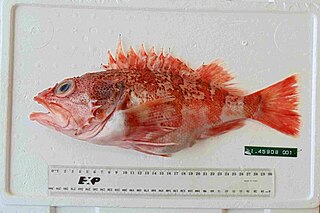
Helicolenus barathri, the bigeye sea perch, bigeye ocean perch, coral cod, coral perch, red gurnard perch, red perch or red rock perch, is a species of marine ray-finned fish belonging to the subfamily Sebastinae, part of the family Scorpaenidae. It is found in the southwestern Pacific Ocean.

Rhinopias xenops, the strange-eyed scorpionfish, is a species of marine ray-finned fish belonging to the family Scorpaenidae, the scorpionfishes. This species is found in the Pacific Ocean.


















